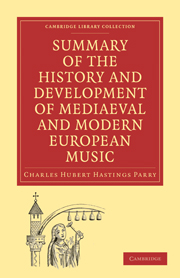Book contents
- Frontmatter
- PREFACE
- Contents
- CHAPTER I THE MUSIC OF THE MIDDLE AGES
- CHAPTER II MUSIC IN ENGLAND FROM THE BEGINNING OF TUDOR TIMES TILL THE RESTORATION OF THE STUARTS
- CHAPTER III THE BEGINNINGS OF OPERA AND ORATORIO
- CHAPTER IV THE PROGRESS OF OPERA IN VARIOUS COUNTRIES, FROM THE MIDDLE OF THE SEVENTEENTH CENTURY TILL THE TIME OF GLUCK
- CHAPTER V ORATORIO IN THE TIME OF BACH AND HANDEL
- CHAPTER VI THE PROGRESS OF INSTRUMENTAL MUSIC UP TO THE TIME OF J. S. BACH
- CHAPTER VII THE PROGRESS OF INSTRUMENTAL MUSIC IN THE EIGHTEENTH CENTURY
- CHAPTER VIII OPERA IN GLUCK AND MOZART'S TIME, AND IMMEDIATELY AFTER
- CHAPTER IX THE PROGRESS OF INSTRUMENTAL MUSIC TO BEETHOVEN AND HIS IMMEDIATE SUCCESSORS
- CHAPTER X MODERN INSTRUMENTAL MUSIC
- CHAPTER XI MODERN OPERA
- CHAPTER XII MODERN VOCAL MUSIC
CHAPTER VI - THE PROGRESS OF INSTRUMENTAL MUSIC UP TO THE TIME OF J. S. BACH
Published online by Cambridge University Press: 29 August 2010
- Frontmatter
- PREFACE
- Contents
- CHAPTER I THE MUSIC OF THE MIDDLE AGES
- CHAPTER II MUSIC IN ENGLAND FROM THE BEGINNING OF TUDOR TIMES TILL THE RESTORATION OF THE STUARTS
- CHAPTER III THE BEGINNINGS OF OPERA AND ORATORIO
- CHAPTER IV THE PROGRESS OF OPERA IN VARIOUS COUNTRIES, FROM THE MIDDLE OF THE SEVENTEENTH CENTURY TILL THE TIME OF GLUCK
- CHAPTER V ORATORIO IN THE TIME OF BACH AND HANDEL
- CHAPTER VI THE PROGRESS OF INSTRUMENTAL MUSIC UP TO THE TIME OF J. S. BACH
- CHAPTER VII THE PROGRESS OF INSTRUMENTAL MUSIC IN THE EIGHTEENTH CENTURY
- CHAPTER VIII OPERA IN GLUCK AND MOZART'S TIME, AND IMMEDIATELY AFTER
- CHAPTER IX THE PROGRESS OF INSTRUMENTAL MUSIC TO BEETHOVEN AND HIS IMMEDIATE SUCCESSORS
- CHAPTER X MODERN INSTRUMENTAL MUSIC
- CHAPTER XI MODERN OPERA
- CHAPTER XII MODERN VOCAL MUSIC
Summary
The history of Instrumental Music divides naturally into three well-defined periods. The first extends from the early experiments in the fifteenth and sixteenth centuries up to the time of J. S. Bach, the second up to Beethoven, and the third till the present day. They are each marked by consistent distinguishing traits. The first by contrapuntal methods akin to those of choral music; the second by the development of pure harmonic forms of the sonata order, which are shown in their highest perfection in the sonatas and symphonies of Beethoven; and the third by a striving after greater freedom than the pure sonata forms seem to allow, or an extension of its scheme by intellectual devices, and new kinds of contrapuntal methods; or by more decisive adoption than formerly of ideas and programmes as the basis of art.
In the early days of the first of these periods modern instruments were not available. The stringed instruments played with bows were the various Viols—treble, mean, tenor, viola da gamba, and violone or double bass. And for this set a quantity of music, both in the shape of dance tunes and of movements copied from choral canzonas and similar choral works was written. Lutes of various sizes were conspicuously popular and useful, and the style of music written for them has permeated many types of more modern music written for other instruments. The position occupied by the pianoforte was held by the harpsichord and the clavichord, and an immense quantity of music of permanent value was written for them in various countries.
Information
- Type
- Chapter
- Information
- Publisher: Cambridge University PressPrint publication year: 2009First published in: 1893
